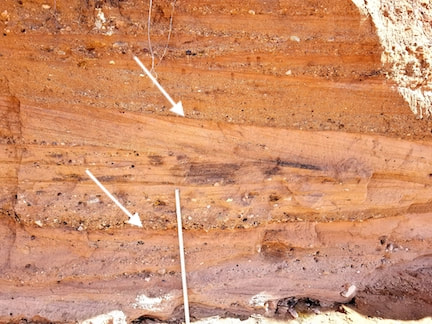The loose clastic sediment left behind by passing floods is called alluvium, from a Latin word that means "to wash against". Although alluvial sediments are deposited by water, the environments in which they accumulate are landlocked: floodplains, abandoned stream channels, or the stony fans and slopes at the foot of desert mountains.
Geologists are much taken up with the notion of environment. Rather than thinking of a solidified deposit of sand or mud as just a "rock", geologists think of it as a "record" - like the record of a flood that left a sand bar in a stream bed, in a land-based environment.
As a friend of mine noted, "I just see dirt unless there are precious stones lying around. Scott sees time capsules."
Sediment can accumulate in many different environments. By observing modern depositional environments and the kinds of sediment left behind in them, geologist gain the tools to work backwards, like a detective.
The clastic sediments left behind in alluvial environments are usually mixed in sizes. The largest particles are commonly rounded by tumbling together in the water. If the water flow has been confined to a channel, some natural sorting may occur. Sand will be piled into sandbars, while silt and clay will be spread over the banks, or passed along downstream. But it is fairly easy to distinguish sediments laid down in alluvial environments from those, say, in abandoned beaches or desert sand dunes.
Below is a photograph of slightly consolidated deposits of clastic sediment laid down in crude layers of rounded gravel mixed with sand and clay. Knowing what we have seen in a modern alluvial environment, we can infer that these deposits accumulated in an ancient alluvial environment. They are the record of a flood or two, in an abandoned stream channel on land, some time in the past. Subsequent erosion has exposed them for us to see.
Geologists are much taken up with the notion of environment. Rather than thinking of a solidified deposit of sand or mud as just a "rock", geologists think of it as a "record" - like the record of a flood that left a sand bar in a stream bed, in a land-based environment.
As a friend of mine noted, "I just see dirt unless there are precious stones lying around. Scott sees time capsules."
Sediment can accumulate in many different environments. By observing modern depositional environments and the kinds of sediment left behind in them, geologist gain the tools to work backwards, like a detective.
The clastic sediments left behind in alluvial environments are usually mixed in sizes. The largest particles are commonly rounded by tumbling together in the water. If the water flow has been confined to a channel, some natural sorting may occur. Sand will be piled into sandbars, while silt and clay will be spread over the banks, or passed along downstream. But it is fairly easy to distinguish sediments laid down in alluvial environments from those, say, in abandoned beaches or desert sand dunes.
Below is a photograph of slightly consolidated deposits of clastic sediment laid down in crude layers of rounded gravel mixed with sand and clay. Knowing what we have seen in a modern alluvial environment, we can infer that these deposits accumulated in an ancient alluvial environment. They are the record of a flood or two, in an abandoned stream channel on land, some time in the past. Subsequent erosion has exposed them for us to see.
Beginning students of geology soon learn this phrase: "The present is the key to the past." In order to understand the record of ancient environments captured by sediment, we spend time observing modern environments where sediment is accumulating now.


 RSS Feed
RSS Feed
